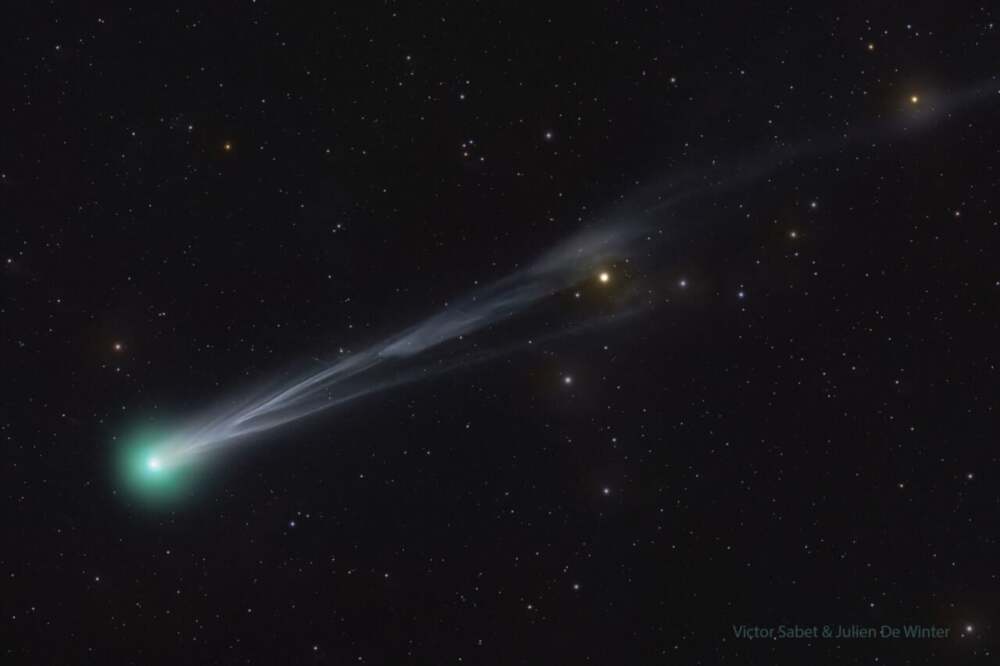This month, skywatchers around the world are turning their gaze upward to witness one of the most breathtaking celestial events of the decade. A newly discovered comet, officially designated C/2025 A6 (Lemmon), is blazing across the night sky in a rare display of cosmic brilliance. The comet, with its emerald-green glow and elegant tail, will soon reach its peak brightness — and then vanish from Earth’s view for more than a millennium.
Astronomers are urging stargazers not to miss this extraordinary visitor, which won’t return for another 1,300 to 1,400 years, making this a once-in-a-lifetime event for everyone alive today.
A Cosmic Discovery at the Edge of Darkness
Comet Lemmon was discovered earlier this year by astronomers at the Mount Lemmon Survey in Arizona, an observatory known for its wide-field sky patrols that detect near-Earth asteroids and comets. Initially, Lemmon appeared as a faint blur among the stars — just another icy wanderer drifting through the outer solar system. But as it journeyed closer to the Sun, astronomers quickly realized that this comet had far more potential than expected.
Its orbit, highly elongated and inclined, indicated it was a long-period comet — one that originates from the distant Oort Cloud, a spherical shell of icy bodies surrounding our solar system. These comets are some of the oldest remnants of planetary formation, holding materials that date back over 4.5 billion years.
By late summer, telescopes began detecting an increase in brightness, suggesting that volatile materials beneath its surface were sublimating — turning from ice to gas — as sunlight intensified. That reaction created a glowing coma, or atmosphere, around its icy nucleus, signaling that Comet Lemmon was awakening.
The Spectacle in the Sky
Throughout October, Comet Lemmon continues to rise in the northern sky, becoming visible shortly before dawn and again in early evening twilight for select latitudes. The comet is expected to reach its closest approach to Earth around October 21, when it will pass at a distance of roughly 56 million miles — close enough for observers under dark skies to potentially glimpse it with the naked eye.
For most viewers, binoculars or a small telescope will offer the best experience. Under ideal conditions, Lemmon is expected to reach a magnitude of +4 to +5, bright enough to be easily seen away from city lights.
Those in the Northern Hemisphere should look toward the constellation Boötes, near the bright star Arcturus, just before sunrise. Over the course of several nights, the comet will move noticeably against the backdrop of stars — a sure sign you’re looking at a true wanderer, not a fixed celestial object.
The comet’s green hue has become its signature feature, glowing vividly in astrophotographs from around the world. This color comes from diatomic carbon (C₂) molecules in the coma, which fluoresce green when illuminated by ultraviolet radiation from the Sun. The effect creates an ethereal, ghostly orb that stands out even against the faint backdrop of dawn.
A Tail of Dust and Ice
As Comet Lemmon approaches its perihelion — the point closest to the Sun — its tail continues to lengthen. Comets form their tails when solar radiation and wind strip away gases and dust from the nucleus. Lemmon currently sports both a dust tail, which curves gently from the comet’s trajectory, and an ion tail, which stretches straight out, pointing directly away from the Sun due to solar wind pressure.
High-resolution telescope images show complex interactions within these tails, including ripples and waves caused by magnetic forces. These features not only provide stunning visuals for observers but also offer scientists invaluable insights into the composition and behavior of ancient icy bodies.
Why Comet Lemmon Matters to Science
While comets are often admired for their beauty, they hold profound scientific significance. They are cosmic time capsules, preserving the original building blocks of the solar system. When they venture close to the Sun, the heat releases these primordial materials, giving astronomers a chance to study the chemical composition of early solar matter.
By observing Lemmon, scientists hope to gather data about its volatile content, isotopic ratios, and mineral dust — details that may help explain how water and organic molecules were delivered to Earth billions of years ago. Instruments on ground-based observatories and space telescopes are already tracking its spectrum to analyze these emissions in real time.
Moreover, the trajectory of Comet Lemmon provides vital information about the gravitational influence of the Sun and giant planets. Each long-period comet that enters the inner solar system offers new data that refine our models of solar dynamics.
A Rare Celestial Opportunity
For skywatchers, Lemmon’s brief visit is a reminder of how fleeting — and precious — such cosmic events can be. Many bright comets appear only once or twice in a generation. The last major naked-eye comet, NEOWISE, dazzled observers in 2020, and before that, Comet Hale-Bopp captivated the world in 1997. Lemmon now joins that exclusive list of celestial wonders visible to the unaided eye.
Unlike meteor showers, which return annually, long-period comets such as Lemmon won’t be seen again for more than a thousand years. When it departs, it will travel far beyond Pluto’s orbit, eventually fading into the darkness of the Oort Cloud — a frozen archive at the outer edge of the solar system.
How to See It
For those eager to catch a glimpse of Comet Lemmon before it disappears, astronomers recommend the following viewing tips:
- Best Time: Around October 18–25, shortly before dawn or just after sunset, depending on your location.
- Direction: Look toward the northeastern sky before sunrise or the northwestern sky after sunset.
- Tools: Binoculars will greatly enhance visibility; a small telescope will reveal its green coma and tail.
- Environment: Find a location away from city lights — rural areas or mountains provide the best contrast.
- Timing: Allow your eyes to adjust to darkness for at least 15–20 minutes before looking for the comet.
Patience is key. Comets are faint, dynamic, and unpredictable. What appears as a dim smudge through binoculars one night might brighten dramatically the next.
A Message Written in the Stars
Comet Lemmon’s appearance is more than just an astronomical curiosity — it’s a profound reminder of humanity’s enduring connection to the cosmos. Long before telescopes existed, ancient civilizations watched comets and recorded them in myths, often interpreting them as omens or signs from the heavens. Today, we understand them as relics of creation — fragments of a time when the solar system itself was being born.
As Lemmon sails back into the outer reaches of space, it leaves behind not prophecy, but perspective: a reminder that our world, vibrant and alive, is part of an intricate, ancient system of celestial motion. The comet’s brilliance may fade, but its story — written in ice, light, and dust — will remain etched in the chronicles of human observation.
So, if the skies are clear this month, step outside, look up, and take a moment to find that faint green glow. You’ll be seeing not just a comet, but a traveler from the dawn of the solar system — one that won’t return until the year 3400 or beyond.
















Leave a Reply